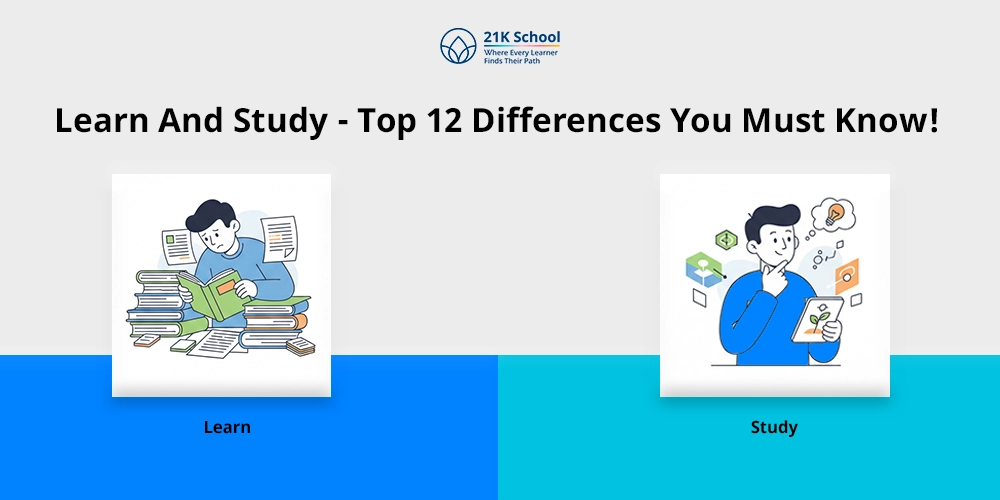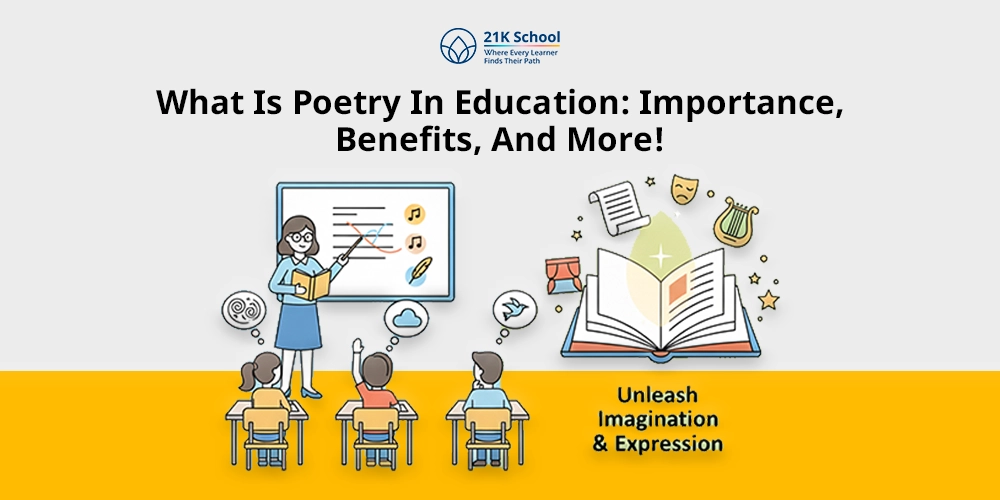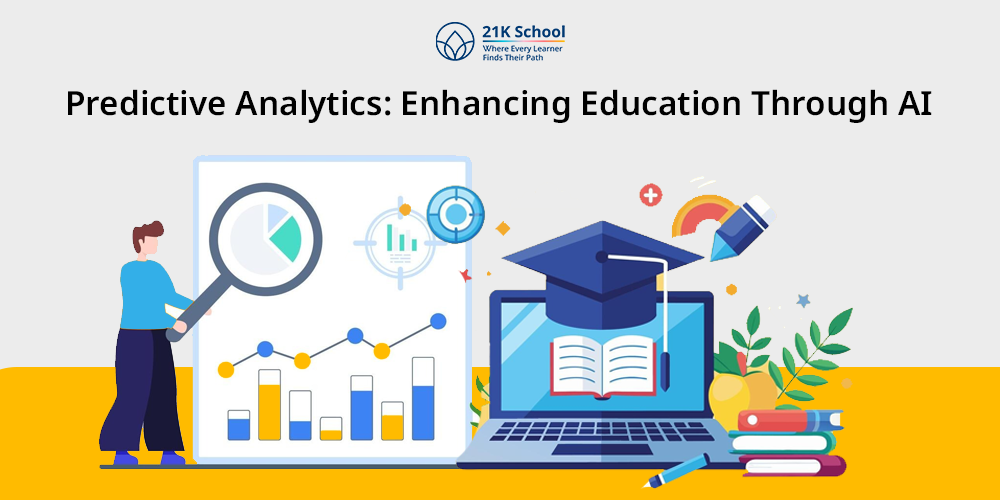
Imagine students get solutions to their academic problem before their grades start to drop. Or schools providing personalised lessons to improve students’ strengths.
Yes it sounds different? But what if it is happening around your kid? Thanks to predictive analytics in education.
In this digital world, education is changing its way of learning and we as a parent teacher or students need something more.
To fulfill this need schools and universities are no longer relying solely on tests and reports to track student progress. However, they’re analysing data.
Data such as attendance records, assignment submissions, online activity, and many more. This data helps in predicting lot more like:
- How will students perform?
- What support might they need in the near future?
So, this proactive approach known as predictive analytics helps teachers to understand circumstances and provide guidance before small issues become big problems.
Contents
- What is Predictive Analytics in Education?
- Why Predictive Analytics Is Important?
- Predictive Analytics Types
- How Predictive Analytics Works in Education?
- Benefits of Predictive Analytics in Education
- Predictive Analytics Applications
- Ways Predictive Analytics Supports Student Success
- AI and Education
- Case Studies of Predictive Analytics in Education
- Ethical Considerations of Using Predictive Analytics in Education
What is Predictive Analytics in Education?

Predictive analytics in education means using previous data and algorithms to understand future student outcomes and identify potential issues.
It allows for early intervention and customized learning tailored to each student’s needs.
Predictive analytics includes analyzing historical and real-time student data, such as grades, attendance, performance etc.
Whether it’s a prediction of students’ struggle in a particular subject or finding solutions to improve academic success, predictive analytics is vital.
Let’s discuss why it’s becoming so important, and the different ways it’s helping students succeed like never before.
Why Predictive Analytics Is Important?

Predictive analytics is one of crucial parts especially for teachers to understand students progress.
It enables organizations to move beyond simply understanding past data to forecasting future outcomes. This makes data-driven decisions that improve efficiency, reduce risk, and enhance profitability.
Let’s elaborate why predictive analytics is important?
1. Improved Decision-Making
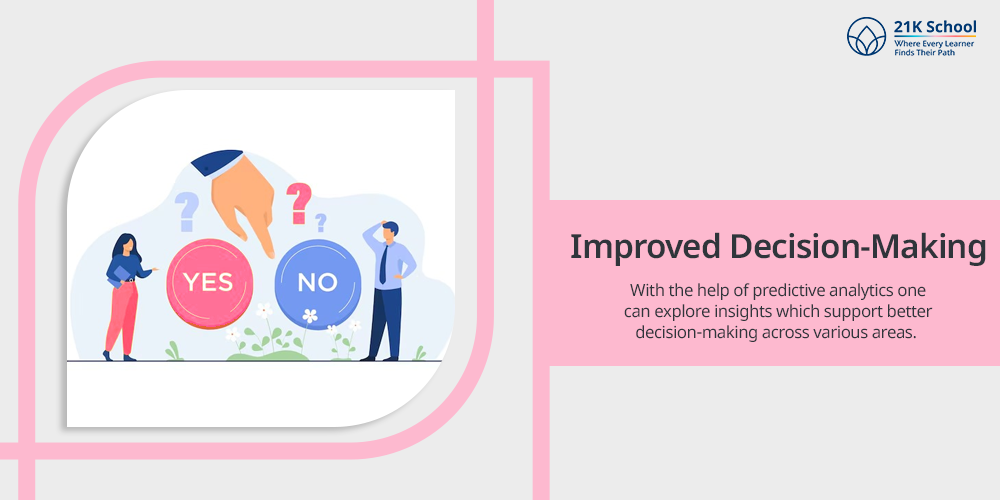
With the help of predictive analytics one can explore insights which support better decision-making across various areas.
Especially in education where teachers look at daily progress reports and customize their tasks.
2. Identifying and Supporting At-Risk Students
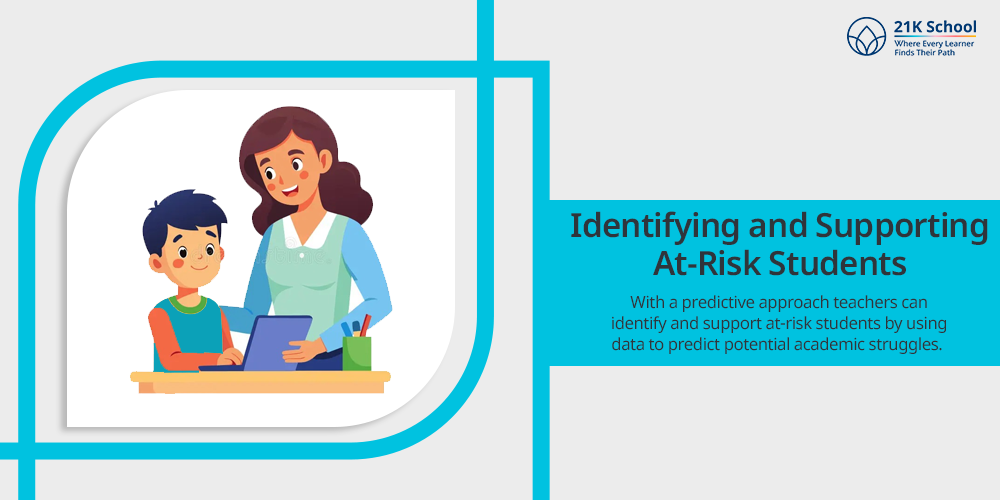
With a predictive approach teachers can identify and support at-risk students by using data to predict potential academic struggles.
This helps teachers to intervene early and provide targeted support. By this end result can be improved.
3. Enhanced Efficiency and Productivity of Learning
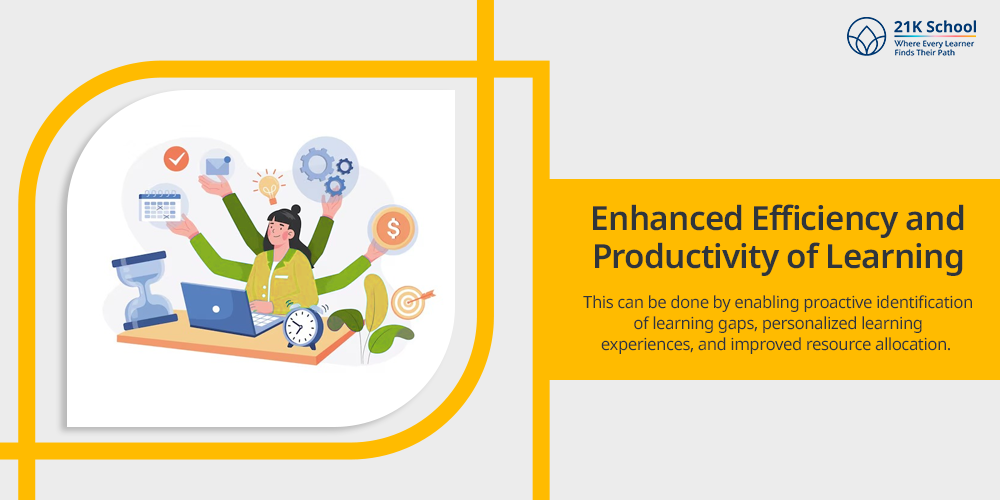
Predictive analytics enhances learning efficiency and productivity of students. This can be done by enabling proactive identification of learning gaps, personalized learning experiences, and improved resource allocation.
Teachers can fulfill students’ need for better knowledge and results. Explore the benefits of personalized learning.
4. Identification of New Opportunities for Students
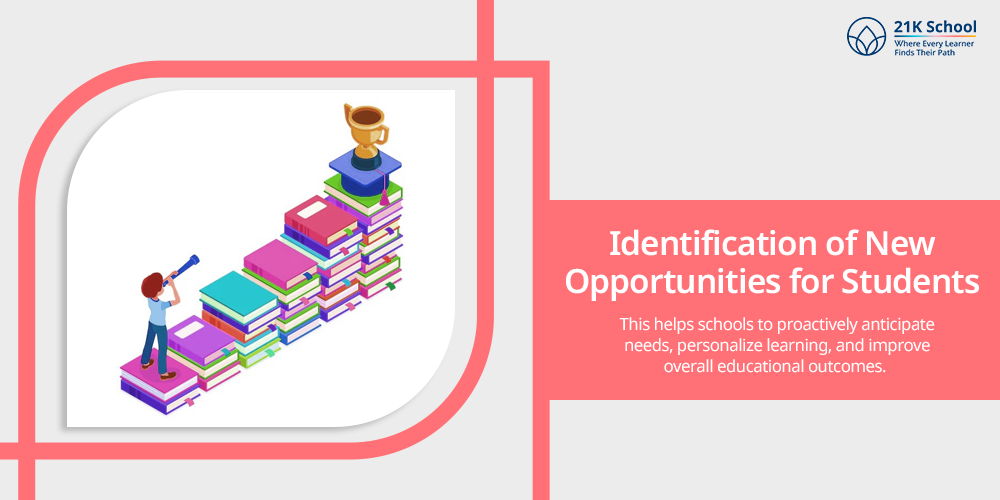
One of the crucial advantages of predictive analytics is identification of new opportunities for students.
This helps schools to proactively anticipate needs, personalize learning, and improve overall educational outcomes.
5. Improving Students Engagement and Performance
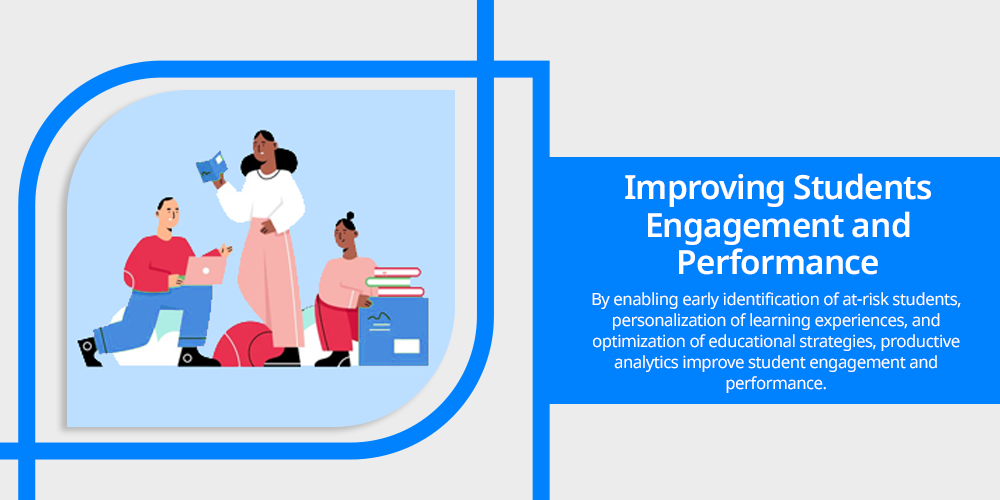
By enabling early identification of at-risk students, personalization of learning experiences, and optimization of educational strategies, productive analytics improve student engagement and performance.
Predictive Analytics Types

Predictive analytics in education is classified into various types. The main three primary categories are regression analysis, time series analysis, and machine learning algorithms.
Let’s understand:
1. Regression Models
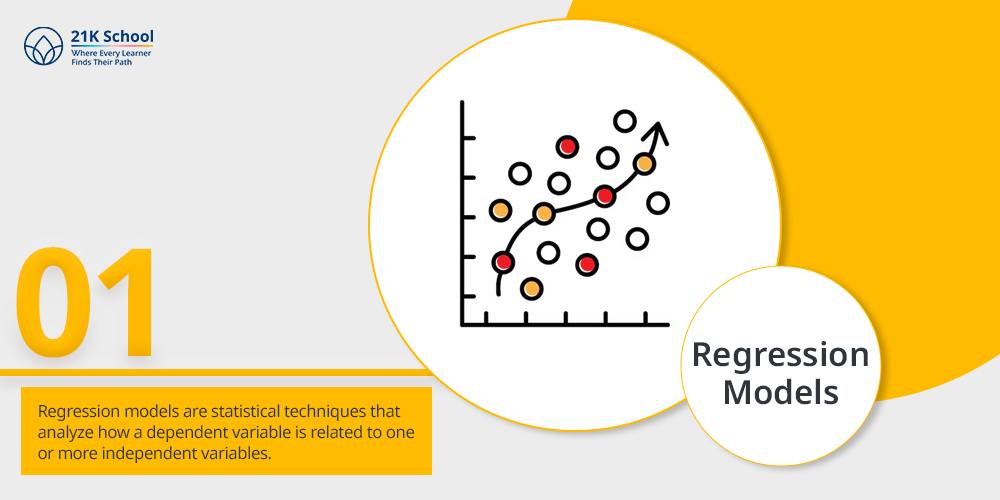
Regression models are statistical techniques that analyze how a dependent variable is related to one or more independent variables.
There are various types of regression models, each suitable for different data scenarios and relationship types.
2. Time Series Analysis
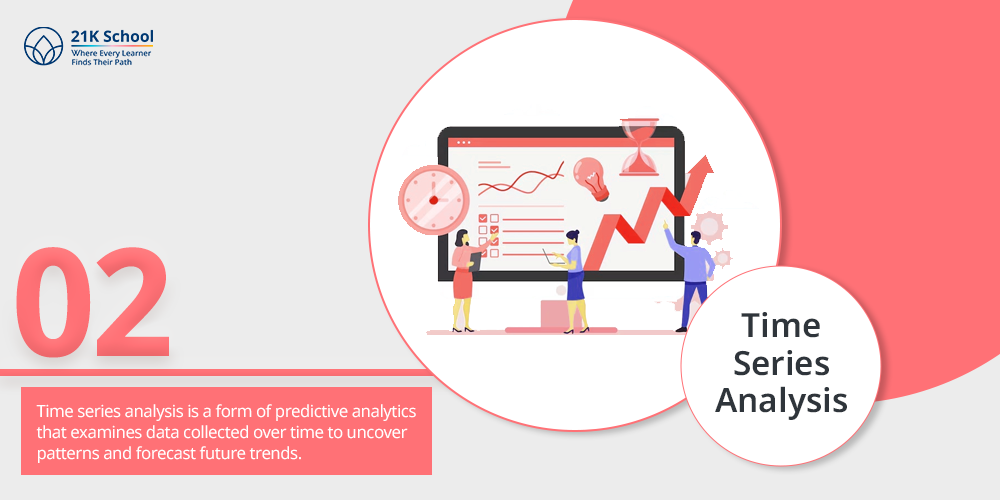
Time series analysis is a form of predictive analytics that examines data collected over time to uncover patterns and forecast future trends.
Types of time series analysis are forecasting, decomposition, and intervention analysis, descriptive analysis etc.
3. Machine Learning Algorithms

ML or Machine learning algorithms are advanced computer models that learn patterns from data and improve their predictions over time without being explicitly programmed for every scenario.
Some common kinds of ML include decision trees, neural networks, random forest, gradient boosting, clustering.
4. Prescriptive Analytics

Prescriptive analytics finds out the optimal course of action based on those predictions and other relevant factors.
5. Other Predictive Analytics Models
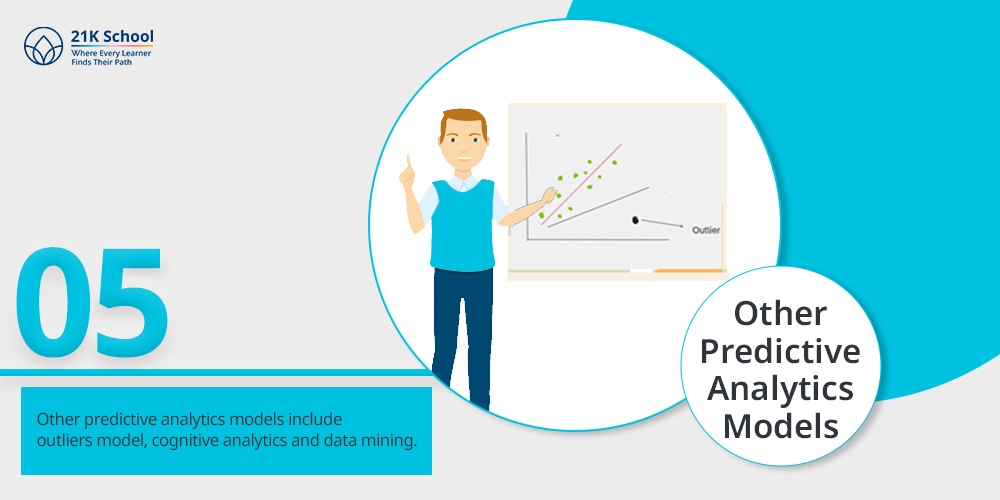
Other predictive analytics models include outliers model, cognitive analytics and data mining.
How Predictive Analytics Works in Education?
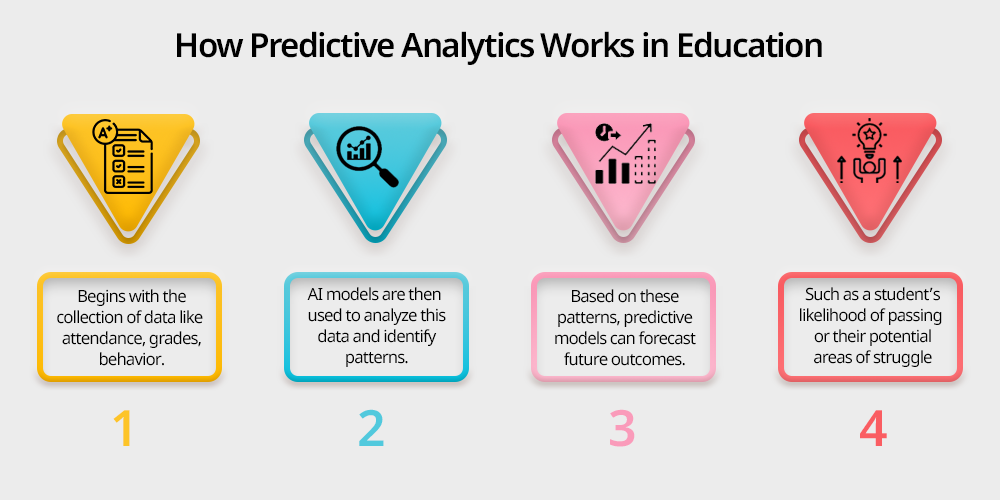
Predictive analytics involves using data, statistical algorithms, and machine learning techniques to predict future outcomes based on historical data.
In the context of education, predictive analytics can be used to analyze student data to predict future performance and identify potential issues that could hinder learning.
The process begins with the collection of data, which could include student attendance, grades, behavior, and online activity.
Advanced algorithms and AI models are then used to analyze this data and identify patterns.
Based on these patterns, predictive models can forecast future outcomes, such as a student’s likelihood of passing a course or their potential areas of struggle.
For instance, if data indicates that a student consistently struggles with a particular subject, predictive analytics can forecast that the student might face challenges in this area in the future.
Educators can then intervene early and provide targeted support to help the student improve.
Benefits of Predictive Analytics in Education
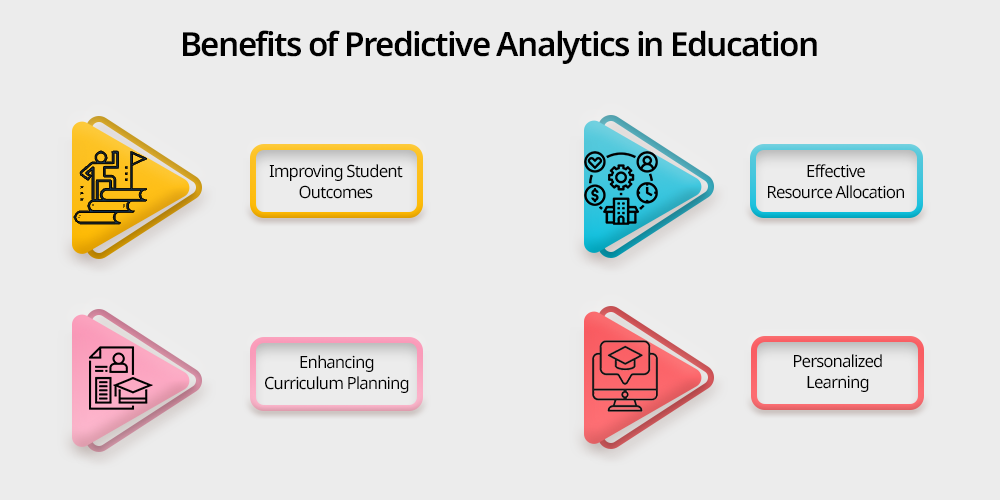
The implementation of predictive analytics in education offers numerous benefits. Here are a few key advantages:
- Improving Student Outcomes: Predictive analytics can help identify at-risk students early in their learning journey. This allows educators to intervene and provide targeted support, improving student outcomes.
- Enhancing Curriculum Planning: By analyzing student performance data, educators can identify which parts of the curriculum are working well and which areas need improvement. This helps in refining the curriculum and teaching strategies to better meet students’ needs.
- Effective Resource Allocation: Predictive analytics can help schools and colleges allocate resources more effectively. By predicting which areas will require more support, institutions can plan ahead and allocate resources where they will be most beneficial.
- Personalized Learning: Predictive analytics can help create personalized learning paths for students, catering to their unique needs and learning styles. This can lead to better engagement and learning outcomes.
The following table illustrates some of these benefits:
| Benefits of Predictive Analytics in Education | Description |
| Improving Student Outcomes | Early identification of at-risk students allows for timely intervention and support. |
| Enhancing Curriculum Planning | Data-driven insights can help refine curriculum and teaching strategies. |
| Effective Resource Allocation | Predictive models can inform better resource planning and allocation. |
| Personalized Learning | Data analytics can aid in creating personalized learning paths for students. |
The use of predictive analytics in education has the potential to significantly enhance the learning experience and outcomes for students.
However, it’s crucial to carefully manage and protect the data used in these processes.
As we continue to integrate AI into our educational systems, we must also consider the ethical implications and strive to create a fair and inclusive learning environment for all.
Discover more about this in our article on the Ethical Considerations of Using AI in Education.
Predictive Analytics Applications

Predictive analytics applications span various industries and use cases, including healthcare, finance, technology, marketing, and more.
Some common examples of predictive analytics applications include:
1. Personalized Learning
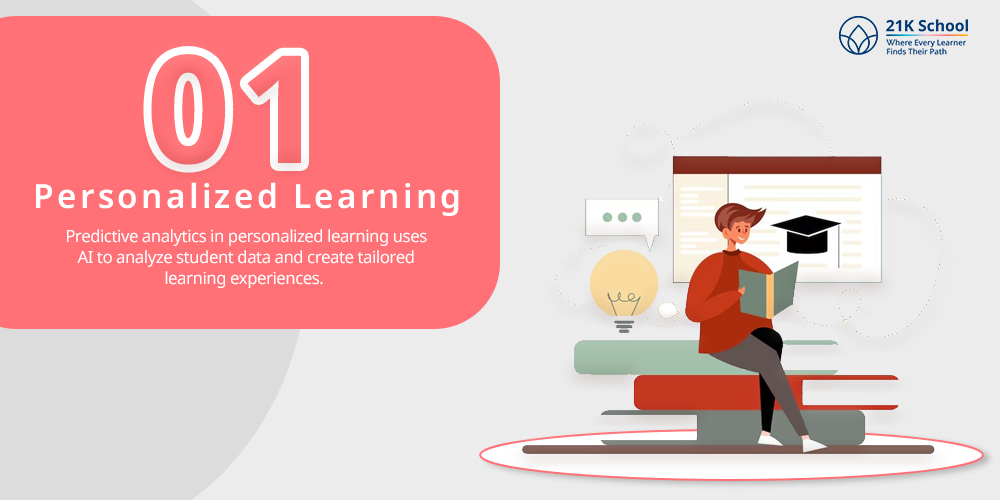
Predictive analytics in personalized learning uses AI to analyze student data and create tailored learning experiences.
This can be done by identifying learning styles, predicting potential struggles, and adapting instruction of students’ needs. This improves engagement.
2. Healthcare
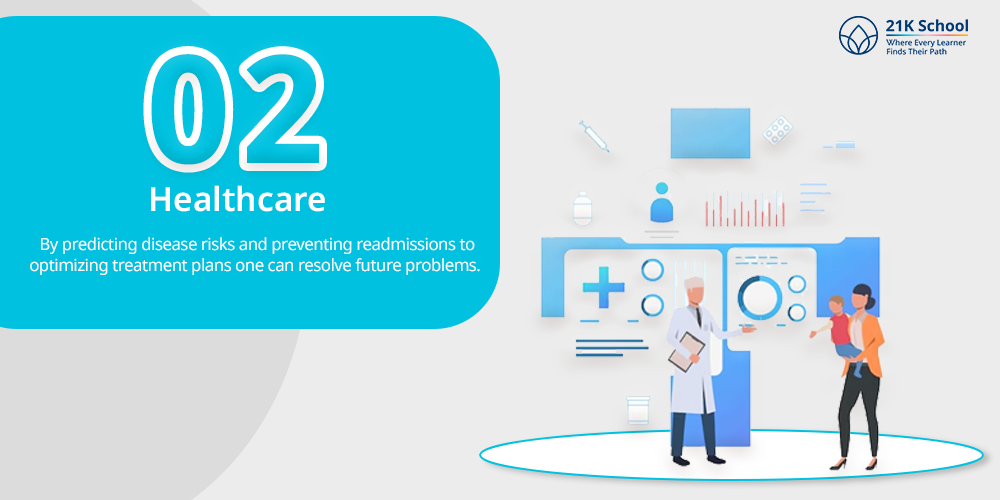
Predictive analytics can be a crucial option for healthcare applications.
By predicting disease risks and preventing readmissions to optimizing treatment plans one can resolve future problems.
3. Technology
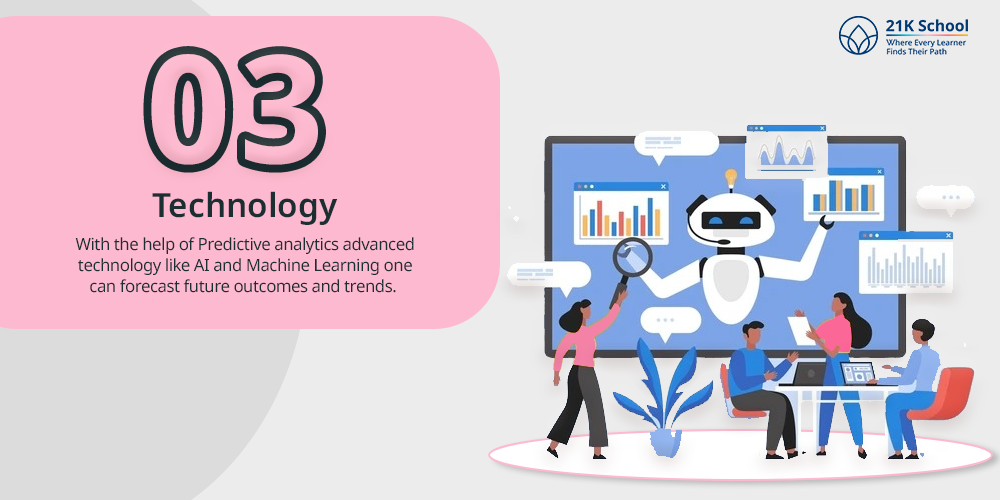
With the help of Predictive analytics advanced technology like AI and Machine Learning one can forecast future outcomes and trends.
Personalizing user experiences, detecting network anomalies, and optimizing system performance are some crucial ways.
4. Finance
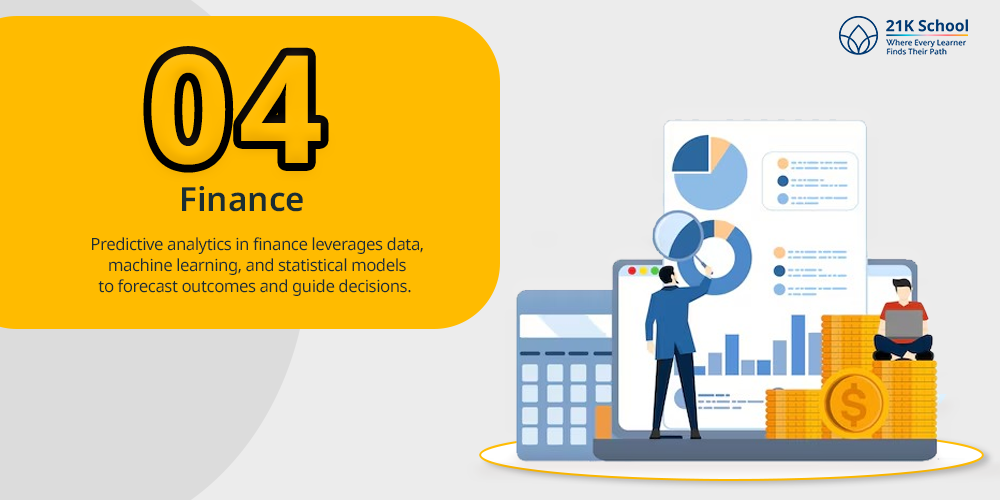
Predictive analytics in finance leverages data, machine learning, and statistical models to forecast outcomes and guide decisions.
It aids in fraud detection, credit scoring, and cash flow forecasting to minimize risks and boost competitiveness.
Ways Predictive Analytics Supports Student Success
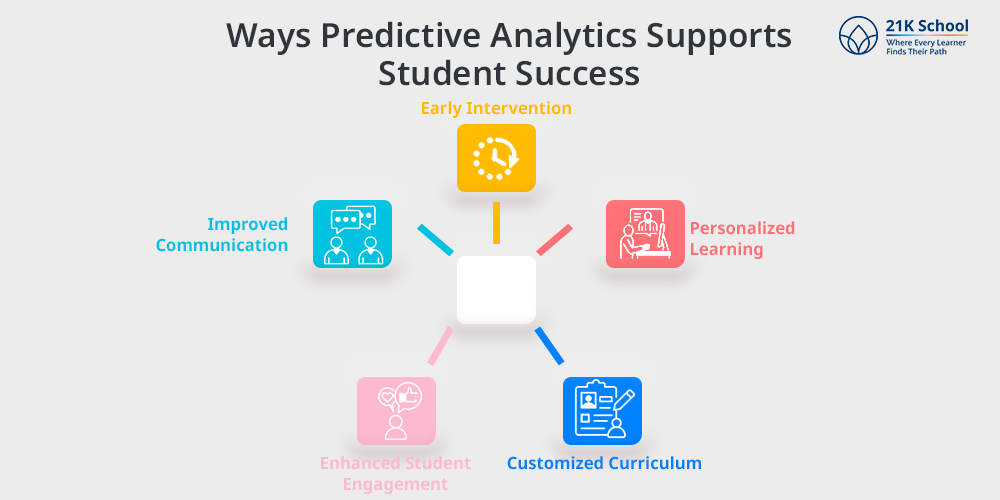
Predictive analytics supports student success by improving academic performance. Here’s how predictive analytics supports student success:
- Early Intervention: By analyzing data like attendance, grades, and engagement, productive models can help students who are struggling or at risk of dropping out. Teachers can step in early and offer tailored support to meet each student’s needs.
- Personalized Learning: Predictive analytics helps in personalized learning experiences to each student’s needs and preferences. This helps boost engagement and achieve more positive outcomes.
- Customized Curriculum: By understanding and analysing the various data teachers can guide students by providing customized curriculum to get desired results in academics. This customization is not only effective but also necessary for students’ learning.
- Enhanced Student Engagement: By early detection of problems and providing effective solutions predictive analytics can increase students’ engagement. To do so, teachers can create a more engaging and effective learning environment.
- Improved Communication: The approach improves communication between students and teachers. It helps in student success by providing insights into potential issues early on, enabling proactive interventions, and personalizing learning experiences.
AI and Education
Artificial intelligence or AI has become an integral part of many sectors, including education.
Its application is rapidly transforming teaching methods, student learning, and administrative processes.
1. Current Use of AI in Education
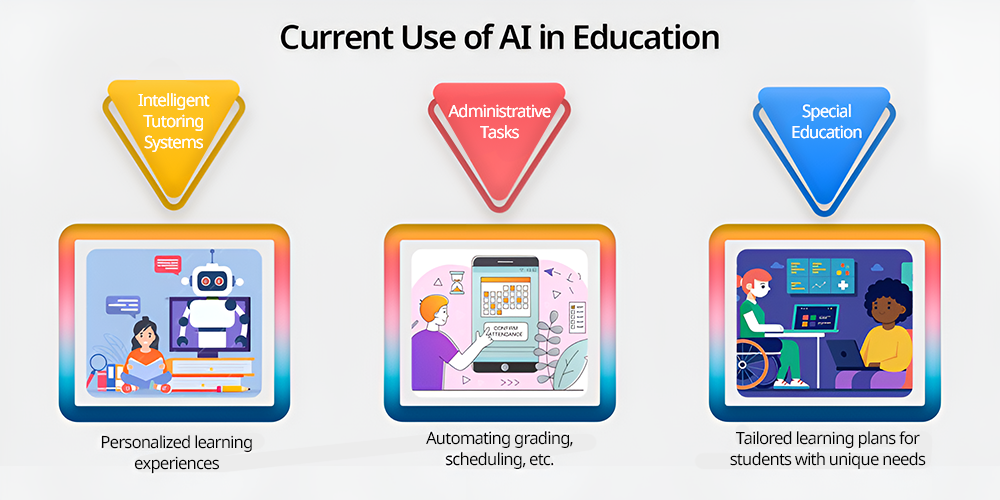
The current usage of AI in the education sector is diverse and evolving. One of the primary applications is in the form of Intelligent Tutoring Systems (ITS).
These systems provide personalized learning experiences for students, adapting to their pace and style of learning. For more insights on this, refer to our article on intelligent tutoring systems.
AI is also utilized in administrative tasks. For instance, AI-driven systems can automate grading, reducing the workload on educators and providing timely feedback to students.
AI has also found its place in special education, where it has been instrumental in creating customized learning plans for students with unique learning needs.
| Current Use of AI | Description |
| Intelligent Tutoring Systems | Personalized learning experiences |
| Administrative Tasks | Automating grading, scheduling, etc. |
| Special Education | Tailored learning plans for students with unique needs |
2. Potential of AI in Enhancing Education
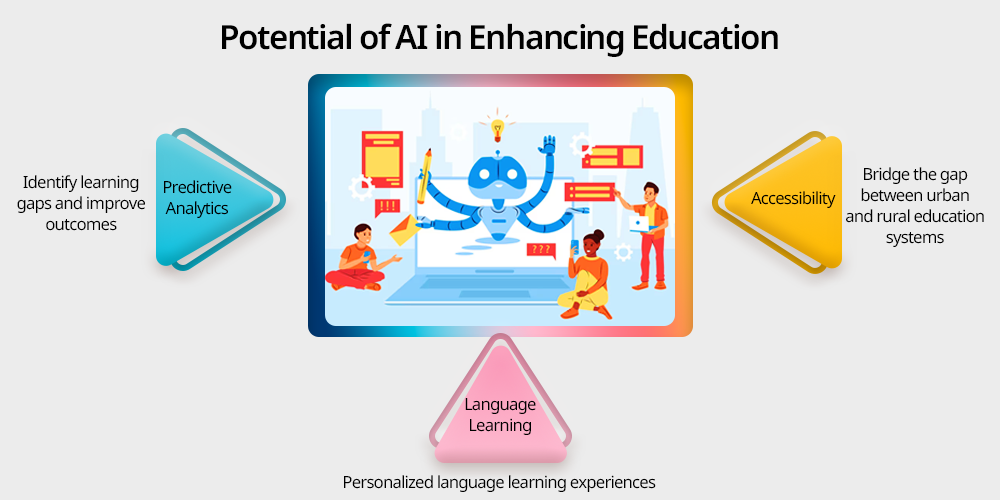
AI holds immense potential in enhancing the educational landscape. One of the future applications of AI in education could be Predictive Analytics.
Through predictive analytics powered by AI, educators can identify learning gaps and intervene proactively to improve student outcomes. Read more about predictive analytics in education.
AI can also revolutionize language learning. Through AI-powered language learning platforms, students can practice pronunciation, learn new vocabulary, and even converse in a new language.
Furthermore, AI has the potential to make education more accessible. AI-driven platforms can provide quality education to students irrespective of geographical barriers, bridging the gap between urban and rural education systems.
| Potential of AI | Description |
| Predictive Analytics | Identify learning gaps and improve outcomes |
| Language Learning | Personalized language learning experiences |
| Accessibility | Bridge the gap between urban and rural education systems |
The intersection of AI and education is promising, with AI’s potential to create a more personalized, efficient, and inclusive educational experience.
However, it’s important to carefully consider the ethical implications, like data privacy and security, to ensure that the benefits of AI in education are realized while minimizing potential risks.
Case Studies of Predictive Analytics in Education
Predictive analytics in education is more than just a buzzword. It’s a tool that is transforming the way we approach teaching and learning.
The following case studies illustrate the potential of predictive analytics in improving student performance, enhancing curriculum planning, and streamlining administrative tasks.
1. Improving Student Performance
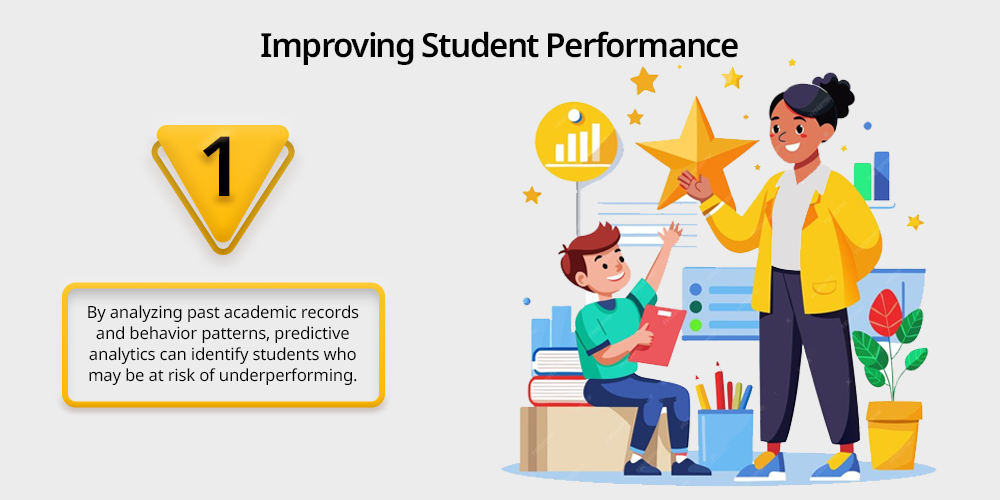
One of the key applications of predictive analytics in education is in the area of student performance.
By analyzing past academic records and behavior patterns, predictive analytics can identify students who may be at risk of underperforming.
This allows educators to intervene early, providing the necessary support and guidance to help these students improve.
For instance, a school district implemented a predictive analytics system to monitor student performance.
By analyzing factors such as attendance, grades, and behavior incidents, the system was able to identify students who were at risk of not meeting academic standards.
As a result, the district was able to implement targeted interventions, leading to a significant improvement in overall student performance.
| Performance Indicator | Before Intervention | After Intervention |
| Average Grades | 68% | 78% |
| Attendance Rate | 85% | 92% |
| Behavior Incidents | 120 | 60 |
2. Enhancing Curriculum Planning
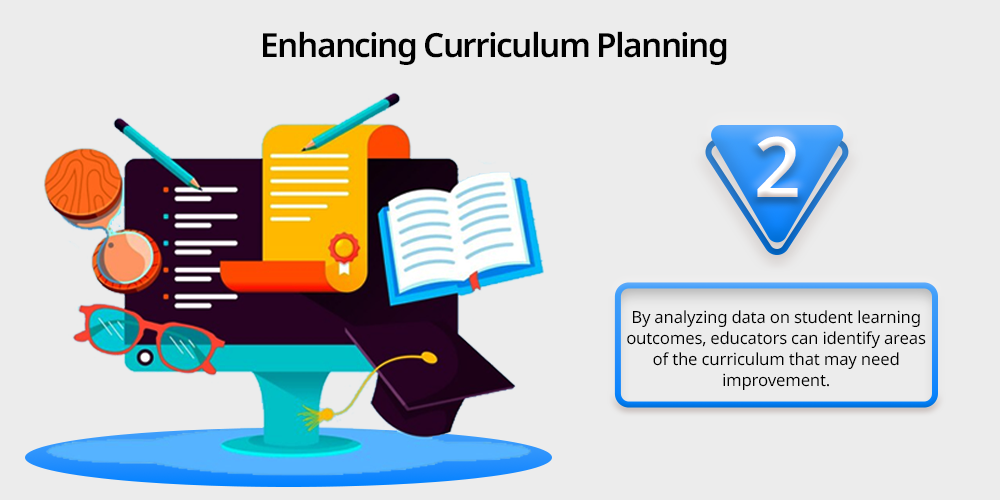
Predictive analytics can also play a crucial role in curriculum planning. By analyzing data on student learning outcomes, educators can identify areas of the curriculum that may need improvement.
This can lead to more effective teaching strategies and better learning outcomes.
In one case, a university used predictive analytics to analyze student performance in different courses. The data revealed that students were struggling in certain areas of the curriculum.
In response, the university revised its teaching strategies and resources for these courses. The result was a significant improvement in student understanding and performance in these areas.
| Course | Before Intervention | After Intervention |
| Mathematics | 65% | 80% |
| Science | 70% | 85% |
| English Literature | 75% | 88% |
3. Streamlining Administrative Tasks
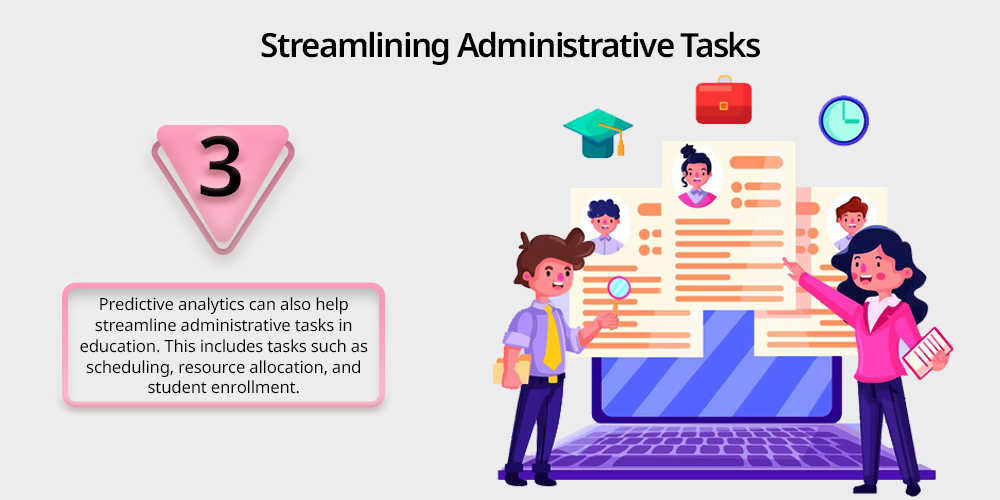
Predictive analytics can also help streamline administrative tasks in education. This includes tasks such as scheduling, resource allocation, and student enrollment.
By predicting trends and patterns, schools can make more informed decisions and improve their operational efficiency.
For example, a school used predictive analytics to forecast student enrollment for the following academic year.
This enabled the school to allocate resources more effectively and plan class schedules more efficiently. The result was a smoother enrollment process and improved resource utilization.
| Administrative Task | Before Intervention | After Intervention |
| Student Enrollment Accuracy | 85% | 95% |
| Resource Utilization | 70% | 85% |
| Class Schedule Efficiency | 75% | 90% |
These case studies provide a glimpse into the potential of predictive analytics in education.
By harnessing the power of data, schools can enhance student learning, improve curriculum planning, and streamline administrative tasks.
Ethical Considerations of Using Predictive Analytics in Education
While predictive analytics in education presents several benefits, it is essential to consider the ethical implications of this technology.
There are three primary ethical considerations to address: data privacy and security, eliminating bias in predictive models, and ensuring equal opportunities for all students.
1. Data Privacy and Security
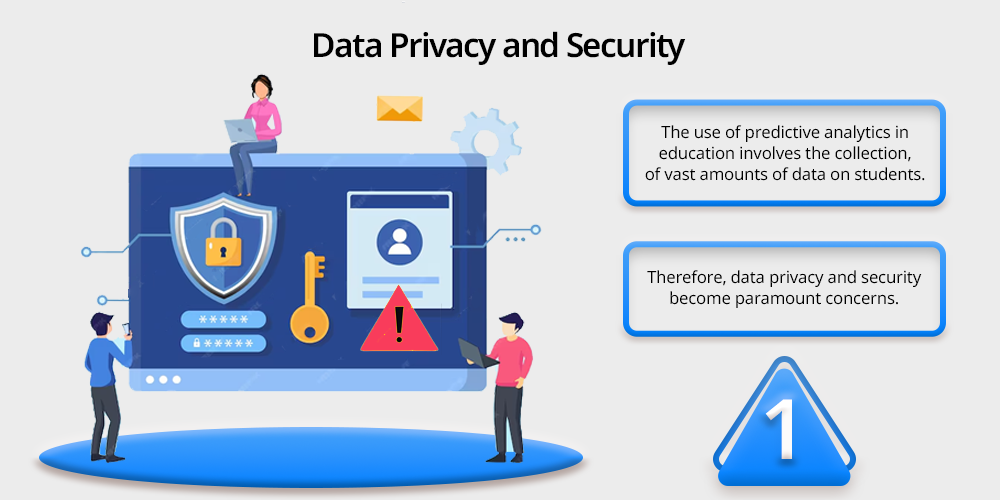
The use of predictive analytics in education involves the collection, analysis, and storage of vast amounts of data on students.
This data includes academic records, behavior patterns, and even personal information. Therefore, data privacy and security become paramount concerns.
Educational institutions must adhere to strict data privacy laws and employ robust cybersecurity measures to prevent unauthorized access to data.
They must also ensure that students and parents are informed about the types of data collected, how it is used, and the measures taken to protect their privacy.
2. Eliminating Bias in Predictive Models
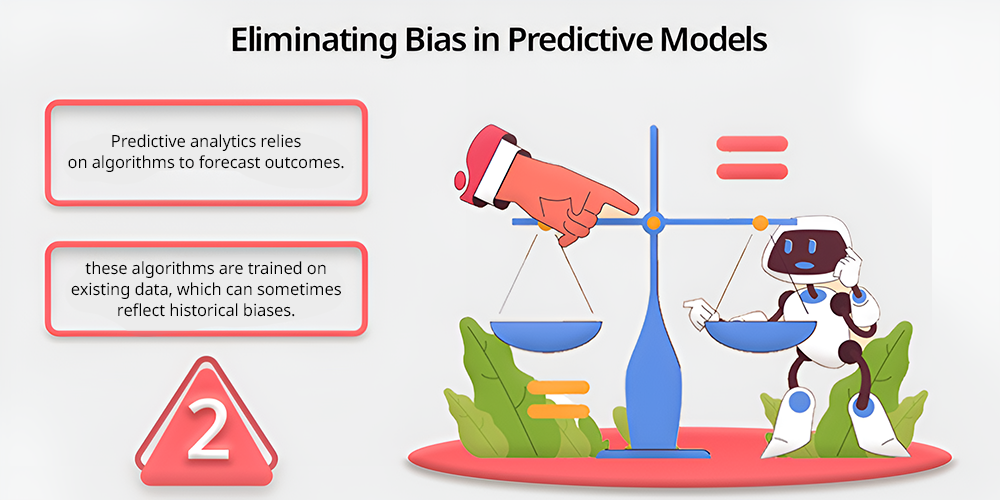
Predictive analytics relies on algorithms to forecast outcomes. However, these algorithms are trained on existing data, which can sometimes reflect historical biases.
If not addressed, these biases can perpetuate inequality or unfair practices in education.
For instance, students from marginalized communities might be unfairly disadvantaged by predictive models that do not account for their unique challenges.
To avoid this, it’s crucial to regularly review and update predictive models to eliminate potential bias.
Additionally, educators must be aware of these potential biases and use predictive analytics as a tool to supplement, not replace, their professional judgment.
Our articles on artificial intelligence in education delve deeper into these issues.
3. Ensuring Equal Opportunities for All Students
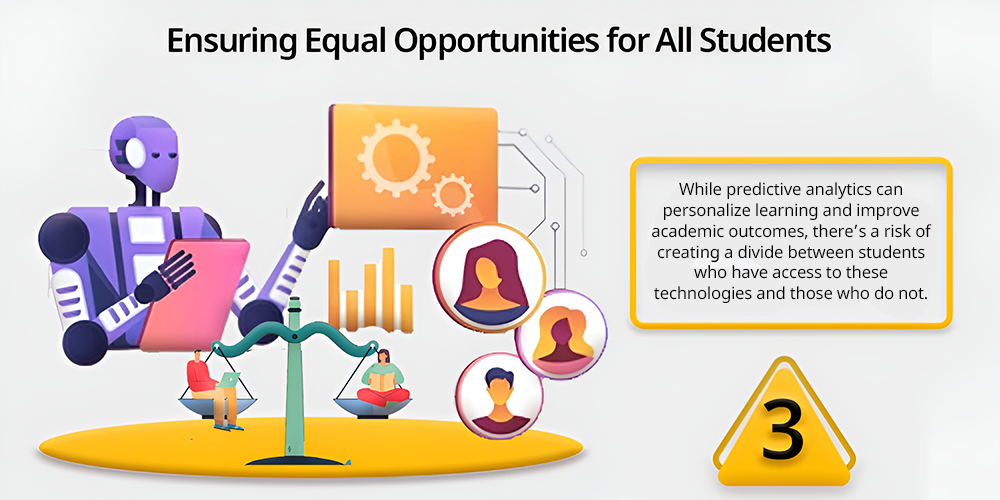
While predictive analytics can personalize learning and improve academic outcomes, there’s a risk of creating a divide between students who have access to these technologies and those who do not.
It is essential to ensure that all students, regardless of their socioeconomic status, have equal opportunities to benefit from predictive analytics.
This might involve investing in infrastructure to provide access to necessary technologies or creating policies that ensure equitable distribution of resources.
More insights on this topic can be found in our articles on AI in higher education and AI in special education.
As the use of predictive analytics in education continues to grow, these ethical considerations will take on even greater importance.
By addressing these issues proactively, we can harness the power of predictive analytics to enhance education while safeguarding the rights and interests of students.

